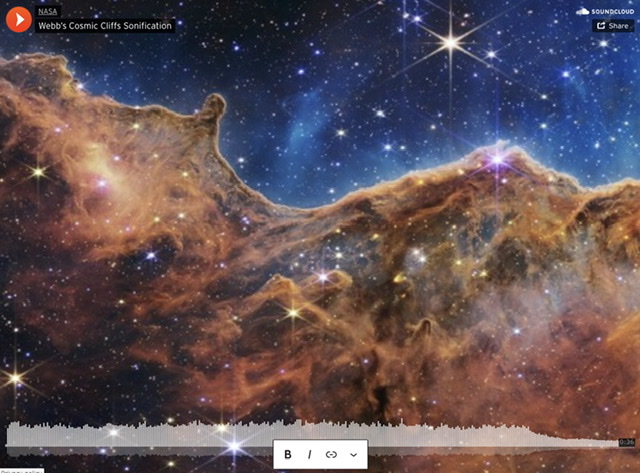*
PRESS RELEASE SOURCE: NASA
*
There’s a new, immersive way to explore some of the first full-color infrared images and data from NASA’s James Webb Space Telescope – through sound. Listeners can enter the complex soundscape of the Cosmic Cliffs in the Carina Nebula, explore the contrasting tones of two images that depict the Southern Ring Nebula, and identify the individual data points in a transmission spectrum of hot gas giant exoplanet WASP-96 b. “Music taps into our emotional centers,” said Matt Russo, a musician and physics professor at the University of Toronto. “Our goal is to make Webb’s images and data understandable through sound – helping listeners create their own mental images.”
*
A team of scientists, musicians, and a member of the blind and visually impaired community worked to adapt Webb’s data, with support from the Webb mission and NASA’s Universe of Learning.
*
*
*
A near-infrared image of the Cosmic Cliffs in the Carina Nebula, captured by NASA’s Webb Telescope, has been mapped to a symphony of sounds. Musicians assigned unique notes to the semi-transparent, gauzy regions and very dense areas of gas and dust in the nebula, culminating in a buzzing soundscape.
*
The sonification scans the image from left to right. The soundtrack is vibrant and full, representing the detail in this gigantic, gaseous cavity that has the appearance of a mountain range. The gas and dust in the top half of the image are represented in blue hues and windy, drone-like sounds. The bottom half of the image, represented in ruddy shades of orange and red, has a clearer, more melodic composition.
*
Brighter light in the image is louder. The vertical position of light also dictates the frequency of sound. For example, bright light near the top of the image sounds loud and high, but bright light near the middle is loud and lower pitched. Dimmer, dust-obscured areas that appear lower in the image are represented by lower frequencies and clearer, undistorted notes.
*
*
NASA’s Webb Telescope uncovered two views of the Southern Ring Nebula – in near-infrared light (at left) and mid-infrared light (at right) – and each has been adapted to sound.
*
In this sonification, the colors in the images were mapped to pitches of sound – frequencies of light converted directly to frequencies of sound. Near-infrared light is represented by a higher range of frequencies at the beginning of the track. Mid-way through, the notes change, becoming lower overall to reflect that mid-infrared includes longer wavelengths of light.
*
Listen carefully at 15 seconds and 44 seconds. These notes align with the centers of the near- and mid-infrared images, where the stars at the center of the “action” appear. In the near-infrared image that begins the track, only one star is heard clearly, with a louder clang. In the second half of the track, listeners will hear a low note just before a higher note, which denotes that two stars were detected in mid-infrared light. The lower note represents the redder star that created this nebula, and the second is the star that appears brighter and larger.
*
NASA’s Webb Telescope observed the atmospheric characteristics of the hot gas giant exoplanet WASP-96 b – which contains clear signatures of water – and the resulting transmission spectrum’s individual data points were translated into sound.
*
*
*
The sonification scans the spectrum from left to right. From bottom to top, the y-axis ranges from less to more light blocked. The x-axis ranges from 0.6 microns on the left to 2.8 microns on the right. The pitches of each data point correspond to the frequencies of light each point represents. Longer wavelengths of light have lower frequencies and are heard as lower pitches. The volume indicates the amount of light detected in each data point.
*
The four water signatures are represented by the sound of water droplets falling. These sounds simplify the data – water is detected as a signature that has multiple data points. The sounds align only to the highest points in the data.
*
*
Mapping Data to Sound
These audio tracks support blind and low-vision listeners first, but are designed to be captivating to anyone who tunes in. “These compositions provide a different way to experience the detailed information in Webb’s first data. Similar to how written descriptions are unique translations of visual images, sonifications also translate the visual images by encoding information, like color, brightness, star locations, or water absorption signatures, as sounds,” said Quyen Hart, a senior education and outreach scientist at the Space Telescope Science Institute in Baltimore, Maryland. “Our teams are committed to ensuring astronomy is accessible to all.”
*
This project has parallels to the “curb-cut effect,” an accessibility requirement that supports a wide range of pedestrians. “When curbs are cut, they benefit people who use wheelchairs first, but also people who walk with a cane and parents pushing strollers,” explained Kimberly Arcand, a visualization scientist at the Chandra X-ray Center in Cambridge, Massachusetts, who led the initial data sonification project for NASA and now works on it on behalf of NASA’s Universe of Learning. “We hope these sonifications reach an equally broad audience.”
*
Preliminary results from a survey Arcand led showed that people who are blind or low vision, and people who are sighted, all reported that they learned something about astronomical images by listening. Participants also shared that auditory experiences deeply resonated with them. “Respondents’ reactions varied – from experiencing awe to feeling a bit jumpy,” Arcand continued. “One significant finding was from people who are sighted. They reported that the experience helped them understand how people who are blind or low vision access information differently.”
*
“One significant finding was from people who are sighted. They reported that the experience helped them understand how people who are blind or low vision access information differently.”
*
These tracks are not actual sounds recorded in space. Instead, Russo and his collaborator, musician Andrew Santaguida, mapped Webb’s data to sound, carefully composing music to accurately represent details the team would like listeners to focus on. In a way, these sonifications are like modern dance or abstract painting – they convert Webb’s images and data to a new medium to engage and inspire listeners.
*
Christine Malec, a member of the blind and low vision community who also supports this project, said she experiences the audio tracks with multiple senses. “When I first heard a sonification, it struck me in a visceral, emotional way that I imagine sighted people experience when they look up at the night sky.”
*
There are other profound benefits to these adaptations. “I want to understand every nuance of sound and every instrument choice, because this is primarily how I’m experiencing the image or data,” Malec continued. Overall, the team hopes that sonifications of Webb’s data help more listeners feel a stronger connection to the universe – and inspire everyone to follow the observatory’s upcoming astronomical discoveries.
*


